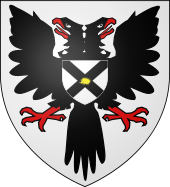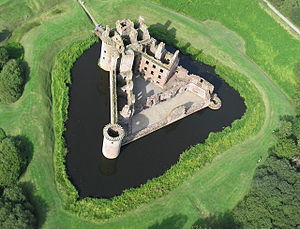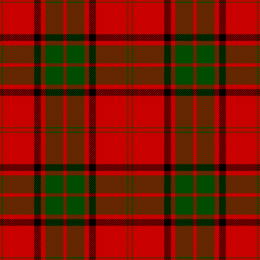- Clan Maxwell
-
Maxwell Crest badge Profile Region Lowland District Dumfries Chief Maxwell has no chief, and is an armigerous clan 
Arms of the last Chief of Maxwell Last Chief: William Maxwell of Carruchan Died: 1863 Historic seat Caerlaverock Castle Septs of Maxwell Adair, Blackstock, Dinwiddie, Dinwoddie, Dinwoodie, Dunwoodie, Edgar, Egarr, Halldykes, Herries, Kirk, Kirkdale, Kirkhaugh, Kirkland, Kirko, Latimer, Latimore, Macetterick, Macettrick, Macgetrick, Macgettrich, Macgettrick, Macghittich, Machethrick, Macittrick, Mackethrick, Macketterick, Mackitterick, Mackittrick, Macsata, Macsetree, Maxey, Maxon, Maxton, Monreith, Moss, Nithdale, Paulk, Peacock, Poak, Pogue, Poke, Polk, Pollock, Pollok, Sturgeon, and Wardlaw Clan Maxwell were a very powerful Lowland Border Family. The Scottish clan does not currently have a chief therefore it is considered an Armigerous clan. The name Maxwell is the name of a Scottish family, members of which have held titles as member of the council of Regency (1536) of the Kingdom of Scotland Regent of Arran, Earl of Morton, Earl of Nithsdale, Lord Maxwell, and Lord Herries.
Contents
History
Origins of the Clan
The name is taken probably from Maccuswell, or Maxwell, near Kelso, Scotland, in the barony of Holydean. The name Maxwell originates from Maccus, a Norman lord and son of Undweyn, who gave his name to Maccuswell, a pool of the river Tweed near Kelso bridge. A grandson of Maccus, John Maxwell, became chamberlain of Scotland before dying in 1241, to be succeeded by his brother Aylmer. From Aylmer sprang many branches of the family throughout the south-west of Scotland.
Spelling variants include Mackeswal, Makiswel, Makiswell, Makkiswell, Miskill, Maxwaile, Maxwale, Maxweel, Maxwell, Maxuel, Maxvall, Maxvile, and Mescall.
Wars of Scottish Independence
Sir Herbert Maxwell won great fame by defending his Caerlaverock Castle against King Edward I of England in 1300. During the Wars of Scottish Independence the Clan Maxwell supported King Robert the Bruce and fought at his side at the Battle of Bannockburn in 1314, under the clan chief of Eustace Maxwell. Herbert, the succeeding clan chief, was knighted by King James I of Scotland for his services to the crown. Another Sir Herbert Maxwell was made a lord of the Scottish parliament before 1445.
16th-century Anglo-Scottish wars and clan conflicts
His great-grandson John, 4rd Lord Maxwell, was killed at the Battle of Flodden Field fighting against the English in 1513 during the Anglo-Scottish Wars. The fifth Lord Maxwell intrigued with King Henry VII of England, although by 1542 King James V of Scotland had appointed him warden of the marches and an Extraordinary Lord of Session and most importantly Regent of Arran the largest island in the Firth of Clyde. Maxwell was captured by the English at the Battle of Solway Moss in the same year.
This was also the time of the Border Reivers. At this time the borderer people's had a much closer allegiance to their governing family/Clan than to their country or King. With the Lord warden's of the marches being the only law. The Maxwells of Nithsdale were the strongest Border Reiver family in the Scottish West March. The Armstrongs and other powerful Border Reiver clans supported the Maxwells, while the Irvines and other turbulent tribes were behind the Johnstones. It is rumored that the Maxwell family could muster around three thousand men to defend themselves or brutally attack their enemies. This was possible by weaker families or peasants giving bonds of manrent to swear allegiance. Although feudalism existed, tribal loyalty was much more important and this is what distinguished the Borderers from the rest of Scotland.
The Clan Maxwell fought on the side of Mary, Queen of Scots at the Battle of Langside in 1568.
Robert's great-grandson John, 7th Lord Maxwell (1553–1593), was the son of Robert, 6th Lord Maxwell (d. 1554), who was son of the 5th Earl and his wife Beatrix, daughter of James Douglas, 3rd Earl of Morton. After the execution of the regent James Douglas, 4th Earl of Morton, in 1581 this earldom was bestowed upon Maxwell, but in 1586 the attainder of the late earl was reversed and he was deprived of his new title. He had helped in 1585 to drive the royal favorite James Stewart, Earl of Arran, from power, and he made active preparations to assist the invading Spaniards in 1588.
There had been a long running feud between Clan Maxwell and the Clan Johnstone. The feud came to a head on 7 December 1593 at the Battle of Dryfe Sands near Lockerbie. The Clan Maxwell army approached the Johnstone town of Lockerbie. Johnstone kept most of his men hidden, just sending a handful of men out on horseback to taunt and provoke the Maxwells. The Johnstones attacked, taking the Maxwells by surprise as they were attempting to ford the river Annan.[1] The Clan Maxwell fared badly that day. In all, it is said that up to 700 Maxwells were killed, but this may be an exaggerated number. Those who escaped wounded were said to bear the marks of "Lockerbie Licks." Their chief, Lord Maxwell, who was one of the most powerful men in southern Scotland, was slain in by the Johnstones. Although Sir James Johnstone escaped punishment from the King for his actions, he did not escape the unforgiving hand of the next Lord Maxwell, son of the chief who was killed at Dryfe Sands. In 1608, Lord Maxwell shot Sir James in the back during a meeting held “under trust,” which rendered him an outlaw. Lord Maxwell was later captured and executed by hanging.[2]
The Maxwells were also at feud with the powerful Clan Douglas over the Earldom of Morton, which he regarded as his inheritance. After a life of exceptional and continuous lawlessness he escaped from Scotland and in his absence was sentenced to death for the murder of Lord Johnstone ; having returned to his native country he was seized and was beheaded in Edinburgh.
17th Century & Civil War
In 1618 John's brother and heir Robert (d. 1646) was restored to the lordship of Maxwell, and in 1620 was created Earl of Nithsdale, surrendering at this time his claim to the earldom of Morton. He and his son Robert, afterwards the 2nd earl, fought under James Graham, 1st Marquess of Montrose for King Charles I during the Wars of the Three Kingdoms. Robert died without sons in October 1667, and his cousin John Maxwell, 7th Lord Herries (d. 1677), became third earl.
18th Century & Jacobite Uprisings
William, 5th Earl of Nithsdale (1676–1744), a grandson of the third earl, was like his ancestor a Roman Catholic and was attached to the cause of the exiled House of Stuart. In 1715 he joined the Jacobites and was taken prisoner at the Battle of Preston; he was sentenced to death and imprisoned in the Tower of London. However with the assistance of his wife, he disguised himself as a serving woman. The couple fled to Rome where the earl died in 1744.


Caerlaverock Castle from the air Castles
- Caerlaverock Castle was the seat of the chief of Clan Maxwell.[1]
- Threave Castle was owned by the Clan Maxwell between 1526 and 1640.[2]
- Maxwell Castle was built in 1545 but destroyed by the English in 1570.[3]
- Newark Castle, Port Glasgow was built by the Clan Maxwell in the 15th century.[4]
- Haggs Castle was owned by the Maxwells from 1585 to 1972.
- Pollok House, the seat of the Maxwell Baronets of Pollok, is now of international importance, as it houses the world-famous Burrell Collection in its grounds.
Tartan
See also
External links
References
 This article incorporates text from a publication now in the public domain: Chisholm, Hugh, ed (1911). Encyclopædia Britannica (11th ed.). Cambridge University Press.
This article incorporates text from a publication now in the public domain: Chisholm, Hugh, ed (1911). Encyclopædia Britannica (11th ed.). Cambridge University Press.
Scottish clans Clans with chiefs Agnew · Anstruther · Arbuthnott · Arthur · Bannerman · Barclay · Borthwick · Boyd · Boyle · Brodie · Broun · Bruce · Buchan · Burnett · Cameron · Campbell · Carmichael · Carnegie · Cathcart · Charteris · Chattan · Chisholm · Cochrane · Colquhoun · Colville · Cranstoun · Crichton · Cumming · Darroch · Davidson · Dewar · Drummond · Dunbar · Dundas · Durie · Elliot · Elphinstone · Erskine · Farquharson · Fergusson · Forbes · Forsyth · Fraser · Fraser of Lovat · Gayre · Gordon · Graham · Grant · Gregor · Grierson · Guthrie · Haig · Haldane · Hamilton · Hannay · Hay · Henderson · Home · Hope · Hunter · Irvine · Jardine · Johnstone · Keith · Kennedy · Kerr · Kincaid · Lamont · Leask · Lennox · Leslie · Lindsay · Lockhart · Lumsden · Lyon · MacAlister · MacBain · MacDonald · Macdonald of Clanranald · MacDonald of Keppoch · Macdonald of Sleat · MacDonell of Glengarry · MacDougall · Macdowall · MacIntyre · Mackay · Mackenzie · Mackinnon · Mackintosh · Maclachlan · Maclaine of Lochbuie · MacLaren · MacLea (Livingstone) · Maclean · MacLennan · MacLeod · MacLeod of Lewis · MacMillan · Macnab · Macnaghten · MacNeacail · MacNeil · Macpherson · MacTavish · MacThomas · Maitland · Makgill · Malcolm (MacCallum) · Mar · Marjoribanks · Matheson · Menzies · Moffat · Moncreiffe · Montgomery · Morrison · Munro · Murray · Napier · Nesbitt · Nicolson · Ogilvy · Oliphant · Primrose · Ramsay · Rattray · Riddell · Robertson · Rollo · Rose · Ross · Ruthven · Sandilands · Scott · Scrymgeour · Sempill · Shaw · Sinclair · Skene · Spens · Stirling · Strange · Stuart of Bute · Sutherland · Swinton · Trotter · Urquhart · Wallace · Wedderburn · Wemyss · Wood ·
Armigerous clans Abercromby · Abernethy · Adair · Adam · Aikenhead · Ainslie · Aiton · Allardice · Anderson · Armstrong · Arnott · Auchinleck · Baillie · Baird · Balfour · Bannatyne · Baxter · Bell · Belshes · Bethune · Beveridge · Binning · Bissett · Blackadder · Blackstock · Blair · Blane · Blyth · Boswell · Brisbane · Buchanan · Butter · Byres · Cairns · Calder · Caldwell · Callender · Campbell of Breadalbane · Campbell of Cawdor · Carruthers · Cheyne · Chalmers · Clelland · Clephane · Cockburn · Congilton · Craig · Crawford · Crosbie · Cunningham · Dalmahoy · Dalrymple · Dalzell · Dennistoun · Don · Douglas · Duncan · Dunlop · Edmonstone · Fairlie · Falconer · Fenton · Fleming · Fletcher · Forrester · Fotheringham · Fullarton · Galbraith · Galloway · Gardyne · Gartshore · Ged · Gibsone · Gladstains · Glas · Glen · Glendinning · Gray · Gunn · Haliburton · Halkerston · Halket · Hepburn · Heron · Herries · Hogg · Hopkirk · Horsburgh · Houston · Hutton · Inglis · Innes · Kelly · Kinloch · Kinnaird · Kinnear · Kinninmont · Kirkcaldy · Kirkpatrick · Laing · Lammie · Langlands · Learmonth · Little · Logan · Logie · Lundin · Lyle · MacAulay · Macbrayne · MacDuff · MacEwen · MacFarlane · Macfie · Macgillivray · MacInnes · MacIver · Mackie · MacLellan · Macquarrie · Macqueen · Macrae · Masterton · Maule · Maxton · Maxwell · McCorquodale · McCulloch · McKerrell · Meldrum · Melville · Mercer · Middleton · Moncur · Monteith · Monypenny · Mouat · Moubray · Mow · Muir · Murray of Atholl · Nairn · Nevoy · Newlands · Newton · Norvel · Ochterlony · Orrock · Paisley · Paterson · Pennycook · Pentland · Peter · Pitblado · Pitcairn · Pollock · Polwarth · Porterfield · Preston · Pringle · Purves · Rait · Ralston · Renton · Roberton · Rossie · Russell · Rutherford · Schaw · Seton · Skirving · Somerville · Spalding · Spottiswood · Stewart · Stewart of Appin · Strachan · Straiton · Strange · Sydserf · Symmers · Tailyour · Tait · Tennant · Troup · Turnbull · Tweedie · Udny · Vans · Walkinshaw · Wardlaw · Watson · Wauchope · Weir · Whitefoord · Whitelaw · Wishart · Young
Culture and society Scotland · Clan chief · Septs · Clan badge · Clan crest · Clan battles · Tartan · Bagpipes · Clearances · Kilt · Manrent · The Highlands · Battle of Culloden · Highland games · Border Reivers · Scottish heraldry · Scottish surnames
Categories:- Scottish clans
- Armigerous clans
Wikimedia Foundation. 2010.

